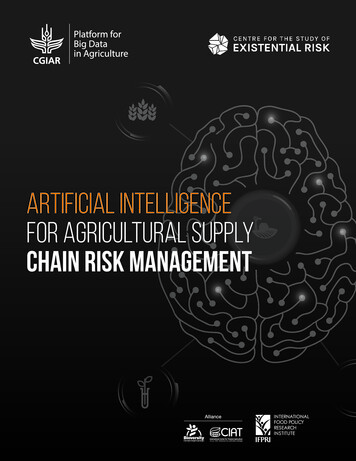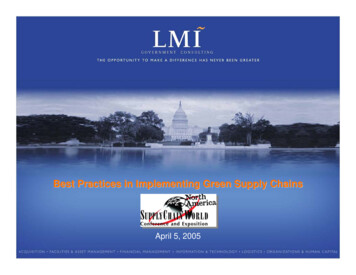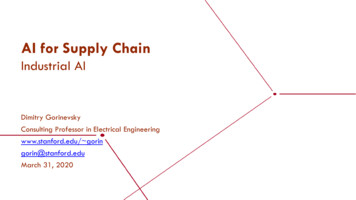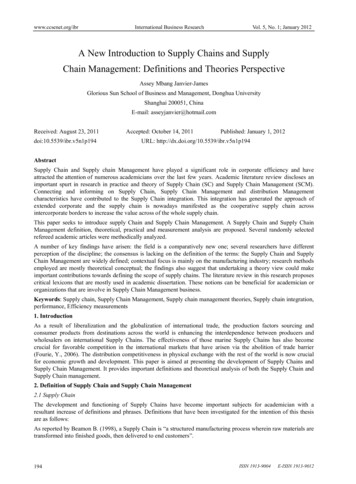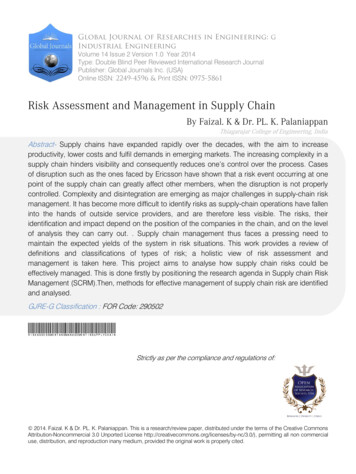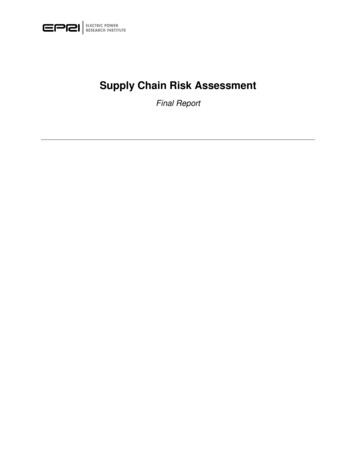
Transcription
Supply Chain Risk AssessmentFinal Report
Supply Chain Risk AssessmentFinal ReportJuly 2018G. RascheELECTRIC POWER RESEARCH INSTITUTE3420 Hillview Avenue, Palo Alto, California 94304-1338 PO Box 10412, Palo Alto, California 94303-0813 USA800.313.3774 650.855.2121 askepri@epri.com www.epri.com
ACKNOWLEDGMENTSThe Electric Power Research Institute (EPRI) prepared this report.G. RascheT. WhitneyB. Sooterii
EXECUTIVE SUMMARYReport Title: Supply Chain Risk Assessment: Final ReportKEY RESEARCH QUESTIONThe North American Electric Reliability Corporation (NERC) Board of Trustees requestedNERC management to “(i)study the nature and complexity of cyber security supply chain risks,including risks associated with low impact assets not currently subject to the Supply ChainStandards, and develop recommendations for follow-up actions that will best address any issuesidentified, and (ii) NERC management provide an interim report to the Board related to theforegoing by no later than approximately 12 months after the adoption of these resolutions anda follow-up final report to the Board no later than approximately 18 months after the adoptionof these resolutions.” The objective of this project is to provide an independent analysis of thesesupply chain risks and develop recommendations for how the electric sector can address them.RESEARCH OVERVIEWEPRI performed this analysis by executing the following tasks:1. Performing a Bulk Electric System (BES) product and manufacturer assessment.2. Analyzing emerging vendor practices and industry standards.3. Analyzing the applicability of the Critical Infrastructure Protection (CIP) standards tosupply chain risks.4. Developing recommendations for follow-up actions that will best address any issuesidentified.KEY TAKEAWAYSIn summary, the analysis performed and documented in this report resulted in three categories ofrecommendations for further analysis and investigation: Applying industry practices and guides: EPRI identified 10 emerging practices that ifapplied effectively could reduce additional supply chain risks. Understanding common-mode vulnerabilities for low-impact BES Cyber Systems(BCS): EPRI recommended additional research to model and assess the impact of acommon-mode exploits targeting multiple, geographically dispersed low-impact BCS todetermine the extent of potential risk of a compromise in supply chain. Assessing supply chain risk through data analysis to address the following topics:o Pre-Audit surveys and questionnaires to help identify and assess industrypracticeso Targeted outreach to vendors that support the reliability of the Bulk ElectricSystemo Development of standardized vendor supply chain practiceso Independent testing of legacy applications and productsiii
WHY THIS MATTERSModern industrial control systems, such as those in the electric power industry, have becomemore sophisticated and complex to deliver better services, deliver more cost-competitiveproducts, and provide greater end-to-end, responsive control. With this evolution has come anincrease in the complexity of the industrial supply chain and as well as additionalinterdependencies across suppliers and service providers. Managing the associated cybersecurity risks is critical for ensuring the reliability of the bulk electric system.HOW TO APPLY RESULTSThis report identifies current supply chain risks for the bulk electric system and providesobjective, technical recommendations to industry for mitigating risks as well as identifyingareas for further analysis. The results may be used to examine current supply chain securityprocesses and requirements to identify opportunities to reduce cyber security risk.iv
CONTENTSEXECUTIVE SUMMARY .V1 INTRODUCTION AND BACKGROUND . 1-12 MARKET DATA ASSESSMENT . 2-1Market Share of Substation Networking Equipment . 2-1Market Share of Operating Systems . 2-2Market Share of Energy Management Systems . 2-2Market Share of Remote Terminal Units . 2-33 ANALYZING VENDOR PRACTICES AND INDUSTRY STANDARDS . 3-14 COMPARING MARKET DATA AND PRACTICES TO THE CIP SUPPLY CHAINSTANDARDS . 4-1Applicability of the Supply Chain Standards to the Bulk Electric System . 4-1Understanding the Risk Basis of the CIP Standards. 4-2Supply Chain Risk Considerations for CIP Applicable Assets . 4-2Processes-Based Procurement Requirements . 4-35 SUMMARY AND ANALYSIS OF CONCLUSIONS . 5-1Applying Industry Practices and Guidelines . 5-1Using Supply Chain Controls to Mitigate Common-Mode Vulnerabilities . 5-1Going Forward: Assessing the Risks Through Data Analysis . 5-26 REFERENCES . 6-1A APPLICABLE STANDARDS . 6-1B EXAMPLE VENDOR PRACTICES . 6-1C MARKET DATA ABBREVIATIONS . 6-1v
LIST OF FIGURESFigure 2-1 Substation communication equipment . 2-1Figure 2-2 Operating systems . 2-2Figure 2-3 EMS vendors . 2-3Figure 2-4 RTU vendors . 2-4Figure 4-1 1262 Registered Entities have BCS . 4-1vii
LIST OF TABLESTable 4-1 CIP Asset Categories . 4-2ix
1INTRODUCTION AND BACKGROUNDAccording to a July 20, 2017 New Jersey Cybersecurity and Communications Integration Cell(NJCCIC) report, “The NJCCIC assesses with high confidence that capable threat actors—bothpolitically-motivated state actors and their proxies, as well as profit-driven criminals—willincreasingly leverage supply chain compromises to conduct network intrusions and attacks.These incidents could result in the exfiltration, manipulation, or destruction of data anddisruption to daily operations and business continuity” [1]. The difficulty of monitoring a supplychain that may include dozens of suppliers at multiple transaction levels is compounded by alack of standardization or security integration between suppliers and buyers.The root cause of escalating supply chain vulnerabilities lies in the increasing dependence onmicroelectronics, computer networks, and telecommunications. Modern industrial controlsystems, such as those in the electric power industry, have become more sophisticated andcomplex to deliver better services, deliver more cost-competitive products, and provide greaterend-to-end, responsive control.The enabling technologies for modernizing the electric power industry include some of thefollowing infrastructure components: Hardware endpoint devices, system monitors, remote switches, and next-generationSCADA/remote telemetry units (RTU) based on programmable logic circuit (PLC),synchronous link control (SLC), and ASIC-based (application-specific integrated circuit)devices. Software for detecting and correcting errors in a power grid system, SCADA/ICS/RTUcontrol and monitoring, PLC/SLC software interfaces, telecommunication/networkingtransports, and power system troubleshooting and analysis software tools.On August 10, 2017, the NERC Board of Trustees approved the proposed Supply Chain RiskManagement requirements: Cyber Security – Supply Chain Risk Management – CIP-005-6, CIP010-3, and CIP-013-1. As part of the approval, the Board proposed additional resolutions forNERC to undertake [2].The NERC Board of Trustees requested that NERC management “study the nature andcomplexity of cyber security supply chain risks, including risks associated with low impactassets not currently subject to the Supply Chain Standards, and develop recommendations forfollow-up actions that will best address any issues identified, and (ii) NERC managementprovide an interim report to the Board related to the foregoing by no later than approximately 12months after the adoption of these resolutions and a follow-up final report to the Board no laterthan approximately 18 months after the adoption of these resolutions.”The objective of this project is to support NERC in the development of its interim report throughthe following tasks:1. Perform BES product and manufacturer assessment.1-1
2. Analyze emerging vendor practices and industry standards.3. Analyze the applicability of the critical infrastructure protection (CIP) standards tosupply chain risks.4. Develop recommendations for follow-up actions that will best address any issuesidentified.1-2
2MARKET DATA ASSESSMENTThe research activities under this task consist of assessing the product/manufacturer types usedon the BES for the following areas: SCADA/control systems, network and telecommunications,and operating systems. The details of the market research market share data are from thefollowing sources: Newton-Evan Research Company Other sources as sited in the References section of this reportBy analyzing the numbers and comparing that data with the systems that are most likely tied toreal-time applications as referenced in the NERC BES Cyber Asset Survey [3], the data providesinsight as to the systems being currently1 procured by asset owners and operators.Market Share of Substation Networking EquipmentAlthough there appears to be a wide array of substation network equipment being purchased, halfof the market share is held by only two vendors (Vendor 1 and Vendor 2). Further, Vendor 2 hasa 55% world-wide enterprise network market share in the corporate environment of manyindustries in addition to the electric power industry.SUBSTATION COMMUNICATION EQUIPMENTOtherVendor 1Vendor 5Vendor 4Vendor 2Vendor 3Figure 2-1Substation communication equipment[1]Newton-Evan Research Company research data is for equipment purchased in 2017.2-1
Market Share of Operating SystemsThe operating system used to govern BES Cyber Systems usually dictates the type of threats andvulnerabilities to which the systems are exposed. Based on the data, Microsoft Windows has an87% market share.As asset owners and operators develop their plans to manage supply chain risk it will beimperative that they give strong consideration to the high prevalence of systems that depend on arelatively small number of vendors and to determine the best means to address vendors that havea stake in their operations. However, asset owners and operators may find it more difficult tonegotiate unique, industry-oriented or asset owner-oriented terms and conditions withinprocurement contracts with large multinational vendors. Unique terms may drive up productcosts or cause delays in the procurement processes.Other2%Windows Server C24%Other OpSys 111%Windows Server A18%Windows Server B45%Figure 2-2Operating systemsMarket Share of Energy Management SystemsThe energy-management system (EMS) platform is widely regarded as one of the most criticalsystems on the bulk electric system. If misused, it could result in significant damage totransmission equipment and potentially lengthy outages.In general, EMS vendors have core customers that are primarily within the critical infrastructuresector, which means that from a supply chain risk management perspective, the electric powerindustry can expect reasonably responsive terms when negotiating security in comparison tovendors that may not have a primary focus in critical infrastructure. Another consideration is thelimited variety of vendors that offer solutions in this category. If a vulnerability is introduced2-2
into a critical supply chain within the system development lifecycle of one of the core vendor’sin this category, the result could be significant to the reliability and security of the BES.EMS VENDORSOthersVendor AVendor DVendor CVendor BFigure 2-3EMS vendorsMarket Share of Remote Terminal UnitsRemote terminal units (RTUs) are microprocessor-based devices that often perform the criticalrole of sending telemetry and control signals between field devices and supervisory control anddata acquisition (SCADA) systems. An observation of note would be the variety of vendors inthis category. No single vendor exceeds 20% market share, which is an indicator that a threat tothe supply chain of SCADA systems would have a lower impact than that of the aforementionedcategories.2-3
RTU VENDORSOthersRTU Vendor 1RTU Vendor 2RTU Vendor 7RTU Vendor 3RTU Vendor 6RTU Vendor 5RTU Vendor 4Figure 2-4RTU vendors2-4
3ANALYZING VENDOR PRACTICES AND INDUSTRYSTANDARDSThe research activities in this task consist of analyzing emerging best practices and standardsused in other industries to mitigate supply chain risks. A key aspect of mitigating supply chainrisk is ensuring that each of the product and service providers adhere to best practices andstandards in security. Ultimately, it is the responsibility of both the purchaser and supplier toensure that their security concerns are understood and that practices to mitigate risk areestablished. The CIP standards are designed to manage supply chain risk and consist of threecore supply chain concepts: Development and implementation of plans and policies to manage supply chain risk (CIP013-1) Testing and validation of software (CIP-005-6) Monitoring and control of vendor connections to BES Cyber Systems (CIP-010-3)Although there are numerous security practices and guides applicable to many aspects ofoperation and information technology, this report focuses on specific standards, vendor practices,and guidelines for mitigating the risks shared by the purchaser and supplier of technologies andservices. The most relevant supply chain practices and standards are referenced in Appendix B(including practices currently not considered in the scope of the CIP standards). Based onresearch performed on each standard or reference in Appendix B, several noteworthy approacheswere identified.1. Off-premise Supplier ServicesIn the scenario, where a supplier performs services for an entity involving BES Cyber Assets thatare not on the Registered Entity’s premises, the FedRAMP standards provide assurance togovernment entities and suppliers, such as cloud service providers. The ISO/IEC 27017,“Security techniques — Code of practice for information security controls based on ISO/IEC27002 for cloud services,” specifies various requirements that recognize that cloud services are atype of supply chain risk. The following is stated in ISO/IEC 27017 regarding a way to addressthe risk of cloud service providers:Cloud service customers and cloud service providers can also form a supply chain.Suppose that a cloud service provider provides an infrastructure capabilities typeservice. In addition, another cloud service provider can provide an applicationcapabilities type service. In this case, the second cloud service provider is a cloud servicecustomer with respect to the first, and a cloud service provider with respect to the cloudservice customer using its service. This example illustrates the case where thisRecommendation International Standard applies to an organization both as a cloudservice customer and as a cloud service provider. Because cloud service customers andcloud service providers form a supply chain through the design and implementation of3-1
the cloud service(s), clause “15.1.3 Information and communication technology supplychain" of ISO/IEC 27002 applies.”Although ISO/IEC 27017 is not widely adopted now, if asset owners and operators decide tomove certain aspects of their operation off-premise, they should be aware of FedRAMP and theISO/IEC 27017 standards.2. Third-Party Accreditation ProcessesSuppliers that provide products to various customers may use accredited standards that areindependently verified. Standards such as FedRAMP, ISO9001, and ISO27001 use independentthird parties to assess their adherence to established standards. The entities that are acquirers orpurchasers of companies that have received accreditation may rely on the work of theindependent auditors to manage supply chain risks. Currently, neither the CIP standards nor theNERC Rule of Procedures allow for vendors or suppliers (non-Registered Entities) to be auditedvia NERC or the Regional Entities. In the context of CIP compliance, a supplier or vendor maybe audited only if they operate a CIP-applicable asset, but the audit results are applicable to onlythe Registered Entity. The Regional Audit reports are not provided to any entity other than theRegistered Entity that is directly involved in the audit. It is worth consideration to determinemethods to share the results of auditing vendor security with Registered Entities to addresscompliance to the CIP standards supply chain risk management. This concept is currentlycontemplated and encouraged in APPA’s Managing Supply Chain Risk-Best Practices for SmallEntities [4].3. Secure Hardware DeliveryMany BES Cyber Assets purchased and deployed on the Bulk Electric System are hardwareappliances that are configured to perform very specific real-time functions. The programming isoften coupled tightly with the physical operation of the device. In those cases, it might be easy tooverlook these types of appliances in the context of supply chain risk management. Appliancessuch as remote terminal units, switches, relays, or other intelligent electronic devices may notseem like software applications, but they often possess code that can be manipulated in a mannerthat causes them to misoperate in and potentially affect the BES. Recognizing this risk, theEnergy Sector Control Systems Working Group (ESCSWG) that developed the CybersecurityProcurement Language for Energy Delivery Systems identified controls for hardware delivery tohelp reduce the risk of compromise during transport:3.6.1. The Supplier shall establish, document, and implement risk management practicesfor ICT supply chain delivery of hardware, software, and firmware. The Supplier shallprovide documentation on its: Chain-of-custody practices Inventory managementprogram (including the location and protection of spare parts) Information protectionpractices Integrity management program for components provided by sub-suppliers Instructions on how to request replacement parts Maintenance commitment to ensurethat for a specified time into the future, spare parts shall be made available by theSupplier. The Supplier shall use trusted channels to ship critical energy delivery systemhardware, such as U.S. registered mail.3-2
4. ProvenanceAs referenced in NISTIR 7622, NIST 800-161, and other guidelines, provenance, or the ability toprovide traceability in the supply chain processes and supplier relationships, improvestransparency and improves vendor assessment processes. Provenance is described in NIST 7622as follows:Acquirers and their system integrators should maintain the provenance of systems and components undertheir control to understand where the systems and components originated, their change history whileunder government control, and who might have had an opportunity to change them. Provenance allowsfor changes from the baselines of systems and components to be reported to specific stakeholders.Creating and maintaining provenance within the ICT supply chain helps government agencies to achievegreater traceability in case of an adverse event and is critical for understanding and mitigating risks.The concept of provenance is a central to concept of supply “chain” practices because each linkor step in the supplier’s process is provided within its provenance documentation. Somechallenges with provenance controls may include the following: Clarity regarding what constitutes a component with a system Ambiguity regarding the authority which has the ability to enforce provenance controls Given the limited number of Bulk Electric System vendors in certain market categories,provenance requirement may have diminishing value, due to similarity of supply chainsfor various entities being supplied by the same vendor5. Threat ModelingThreat modeling as described by the IEC 62443-4-1 Secure Product Development Life-CycleRequirements is “ a process shall be employed to ensure that all products shall have a threatmodel specific to the current development scope of the product ” This ensures the risk ofprocurement of any application or systems is appropriately weighed against the risk ofcompromise to the overall health of the organization or the Bulk electric System. EPRI appliedpart of its risk management and supply chain guidance, Technical Assessment Methodology2,from the threat modeling concept. For instance, if an entity was procuring a new remote accesssystem to its medium-impact substations, the threat model should reflect the impact of theremote access system’s effect to the BES, and the requirements for that purchase should beapplied according to its elevated risk and system-specific vulnerabilities.6. Assessing Supply Chain DeficienciesNIST SP 800-53 - Security and Privacy Controls for Federal Information Systems andOrganizations System and Services Acquisition, Section SA-12 (15) 08023/?lang en3-3
The organization establishes a process to address weaknesses or deficiencies in supplychain elements identified during independent or organizational assessments of suchelements.Clearly addressing the controls for identifying and mitigating the risk of assessed vulnerabilitiesor inherent weaknesses in the supply chain process of certain product or service providers is animportant risk management approach. By using this method of mitigating risk by identifying keyprocess deficiencies, asset owners and operators may decrease their supply risk by implementingtimely organizational assessments.7. Recognizing External DependenciesThe Department of Energy’s Cyber Security Capabilities Maturity Model (C2M2) highlightsmanners to assess the effectiveness of various security processes within utility organizations.One aspect considered by the C2M2 is considering supply chain as a process of identifying andmanaging external dependencies. Recognizing dependencies and those that are most critical tooperations can improve the entity’s ability to highlight and mitigate supply chain risks. TheC2M2 adds:Supply chain risk is a noteworthy example of a supplier dependency. The cybersecuritycharacteristics of products and services vary widely. Without proper risk management,they pose serious threats, including software of unknown provenance and counterfeit(possibly malicious) hardware. Organizations’ requests for proposal often give suppliersof high-technology systems, devices, and services only rough specifications, which maylack adequate requirements for security and quality assurance.8. Policy for Handling Supplied Products or Services That Do Not Adhere to ProcurementProcessesThe U.S. Nuclear Regulatory Commission (NRC) identified processes to manage supplier risks.In its standard, the NRC considered a control to mitigate risks when products or services aresupplied that do not adhere to supply chain policies. The NRC recognizes that companies mayintroduce third-party supplied systems that may not fully adhere to policy but still provides atransparent method to mitigate risks in those events. The NRC states the following in AppendixB, Part 50, Article XV:Measures shall be established to control materials, parts, or components which do notconform to requirements in order to prevent their inadvertent use or installation. Thesemeasures shall include, as appropriate, procedures for identification, documentation,segregation, disposition, and notification to affected organizations. Nonconforming itemsshall be reviewed and accepted, rejected, repaired or reworked in accordance withdocumented procedures.9. Unsupported or Open-Sourced Technology ComponentsAlthough the grid is constantly being modernized by the addition of various technologies, thereare still legacy systems that are not supported by a vendor. In these cases, it does not mean thesupply chain risk management plan is not applicable to these systems. Instead, differentprocesses must be considered to effectively mitigate their risk while updating systems or system3-4
components during the end-of-life phase of the product. NIST SP 800-53 - Security and PrivacyControls for Federal Information Systems and Organizations System and Services Acquisitionstates the following regarding unsupported system components:The organization: a. Replaces information system components when support for thecomponents is no longer available from the developer, vendor, or manufacturer; and b.Provides justification and documents approval for the continued use of unsupportedsystem components required to satisfy mission/business needs.The concept of replacing or developing a plan for an unsupported system or system componentsis a vital aspect of grid security. Currently CIP-007’s Patch Management requirement does notmandate that any compensating controls are implemented when a patch source is not available(i.e. the system is no longer supported). If these systems are left unchecked, significant risk couldremain unmitigated on the BES.Related to products that are not supported by the vendor, many products are based on opensourced applications. The Open Group3 created a set of standards and certification processestitled the “Open Trusted Technology Provider Standard (O-TTPS) Certification Program.” TheO-TTPS standard identifies several supply chain-related controls for purchasers. One of itsstandards addresses open-sourced providers and requires the following in Section 4.2.1.10 of theO-TTPS and ISO/IEC 20243:2015:In the management of Open Source assets and artifacts, components sourced shall beidentified as derived from well-understood component lineage.In the management of Open Source assets and artifacts, components sourced shall besubject to well-defined acceptance procedures that include asset and artifact security andintegrity before their use within a product.For such sourced components, responsibilities for ongoing support and patching shall beclearly understood.10. Concluding Supplier RelationshipsAn important aspect of managing suppliers is knowing how to terminate relationships with thirdparties in manner that limits the operational impact of losing the product or service. The UTC’s“Supply Chain Risk Management for Utilities” paper highlights approaches that utilities canconsider when concluding the supplier relationship. On page 13, it states the following:[U]tilities need to be very conscious of organizing supplier relationship termination processesthat minimize security risks after the relationship is completed. Specifically, utilities shouldensure that the ending of a relationship with a supplier that involves a transition betweendifferent suppliers or from a supplier to the utility involves an organized transition plan wherethe current supplier’s responsibilities and activities are assumed by the receiving party.3https://ottps-cert.opengroup.org/3-5
4COMPARING MARKET DATA AND PRACTICES TOTHE CIP SUPPLY CHAIN STANDARDSThe research activities in this task consist of analyzing the results of the market assessment in Task1 to compare the supply chain risk of different categories of NERC applicable systems such as: High and Medium Impact BES Cyber Systems (BCS) Electronic Access Control or Monitoring Systems (EACMS) Physical Access Control Systems (PACS) Low Impact BES Cyber Systems (BCS)Applicability of the Supply Chain Standards to the Bulk Electric SystemThe CIP Standards are applicable to three categories of assets on the Bulk Electric System(BES): high, medium, and low. The high and medium impact categories have the mostrequirements, while low impact has the least. The Supply Chain Standard (CIP-013-1) isapplicable to high and medium impact categories BES Cyber Systems only. Figure 4-1 (createdfrom data supplied by NERC) shows that roughly 21% of the BES, or 270 Registered Entities,have either high or medium impact BES Cyber Systems. The remaining 79% of the assets, or992 Registered Entities, are low impact and are not applicable to the supply chain requirements.Only low impact BCSLow impact and notsubject to CIP‐01379%high or medium BCSSubject to CIP‐01321%Figure 4-11262 Registered Entities have BCS4-1high or medium BCS21%
Understanding the Risk Basis of the CIP StandardsThe CIP Standards employ an
On August 10, 2017, the NERC Board of Trustees approved the proposed Supply Chain Risk Management requirements: Cyber Security - Supply Chain Risk Management - CIP-005-6, CIP-010-3, and CIP-013-1. As part of the approval, the Board proposed additional resolutions for NERC to undertake [2].



